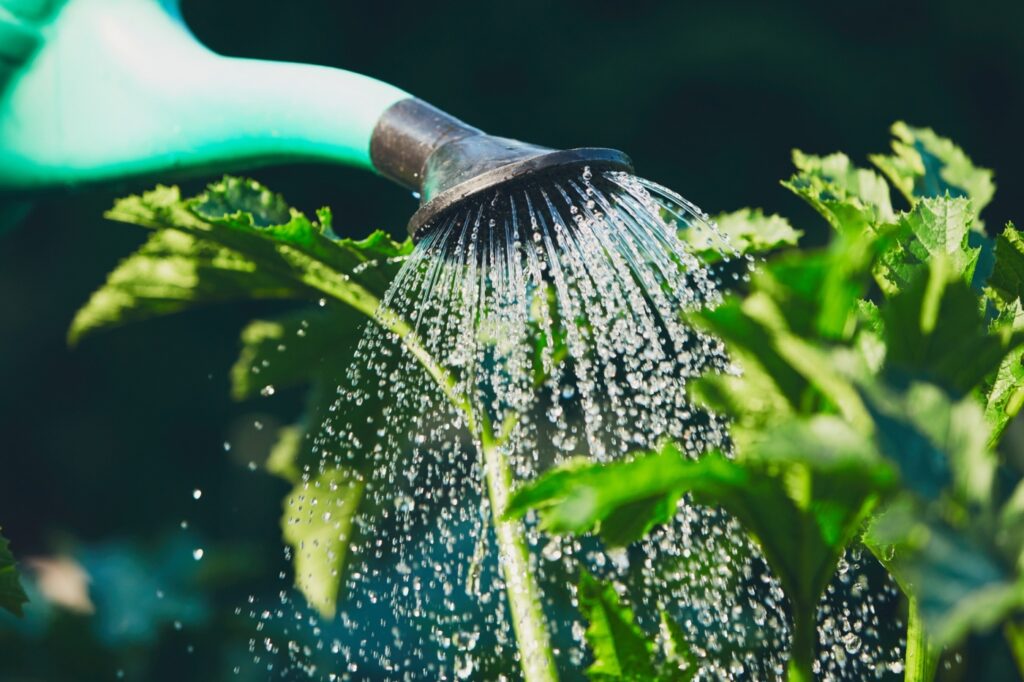
1. With new water restrictions coming into place, it is necessary to be attentive to weather on a daily basis and take a close look at our plants each day to see if we see tell-tale signs of water stress before soaking them. Watering on a set schedule is not conducive to conservation. June brings overcast mornings that sometimes stretch into the afternoon. Such days can lengthen irrigation intervals. Also, be aware that some plants begin to wilt in the afternoon but are standing upright again the next morning, meaning they are not yet in need of water. Other plants may only need to be watered when their leaves begin to curl a little along their margins. Moisture meters are useful for determining when to water and they are available for $7-$15 dollars, suitable for both indoor and outdoor plants. As a general rule, indoor and other container plants need watering when soil is dry at a two-inch depth whereas vegetables growing in the ground need watering when soil is dry at a three-inch depth and fruit trees need water when soil is dry at a four-inch depth. Do not water uniformly but according to the depth of a plant’s roots. You can also check moisture by means of a soil probe, which extracts soil cores to a depth of three feet.
2. Strawberries shoot out lots of runners this time of year, producing more leaves at the expense of flowers and fruit. Remove the runners and fertilize with a product that contains phosphorus and potassium, but no nitrogen since nitrogen encourages leafy growth. Keep a mulch of pine needles or straw around your strawberries since they will quickly rot if they come in contact with the soil surface. However, the origin of the word “strawberry” has nothing to do with straw, but rather with a corruption of the word “strewn.” Strawberries are the only fruit whose seeds (achenes) are located on its skin and appear to be strewn all over it. Alternatively, strawberries grow in a manner that makes them appear as if strewn upon the soil.
3. Trap sow bugs and pill bugs by inverting pieces of watermelon rind around your plants. In the morning you will see them clustered against the fleshy undersides of the rinds which can then be tossed in the trash. The difference between sow bugs and pill bugs is that the former have tail-like appendages and the latter do not. Also, pill bugs can roll up into a ball and are sometimes called roly-polies for this reason. Incidentally, if you see pill bugs that are blue or purple in color, it is a sign that they have a viral infection, but it does not make them dangerous to people or pets. Sow bugs and pill bugs are the only crustaceans who spend their entire lives on land. They will nibble fruit that falls on the ground or grows near the soil surface and may also dine on roots and leaves, especially of young seedlings.
4. Vines that bloom in summer are starting to flower now so take a look at them in the nursery to see which strikes your fancy. If you have an unattractive chain link fence or block wall, you may want to cover it with a flowering vine. Blood-red trumpet vine (Distictis buccinatoria) grows rampantly on freeway barrier walls from Orange County to Los Angeles so it is clearly capable of withstanding drought as all plants grown along freeways must be. Other choices to consider are the fragrant, if rarely seen, Madagascar jasmine (Stephanotic floribundus), the more familiar star jasmine (Trachelospermum jasminoides), pink or white bower vine (Pandorea jasminoides), and the mauve to purple trumpet vine (Distictis ‘Rivers’).
5. If you are looking for a tough woody perennial, fiberglass plant (Wigandia urens) is for you. Native to the Central American cloud forest, where it thrives at altitudes above 6,000 feet, this plant has somehow naturalized on the slopes of Beverly Glen Boulevard, south of Mulholland Drive near Perdido Lane, and on Sunset Boulevard east of the 405 Freeway opposite Thurston Avenue. Fiberglass plant, growing to a height of twelve feet, is a gaudy species with enormous leaves and opulent purple flower clusters. Wigandia seeds are readily available through online vendors.
Related Articles
Community garden helps immigrants put down roots
Why this hardy fruit tree might be just what you want in your garden
Can you afford to buy a house? Try this price calculator
How to create a comfortable space at home for your fitness and workout routine
Why this hardy, low-water groundcover might be your green grass alternative
Naturalization refers to the phenomenon of a plant spreading throughout an area with no human assistance. True, someone had to plant the original specimen, but then, entirely on its own, it propagates itself. Sometimes this happens through self-sowing, as in the case of fiberglass plant. Other times, the phenomenon occurs through vegetative propagation or self-cloning, as in the case of bulbous, rhizomatous or tuberous plants, whether daffodils or Dietes, daylilies or dahlias. Fiberglass plant may occasionally naturalize through the growth of rhizomes as well.
Send questions, comments, and photos to joshua@perfectplants.com
